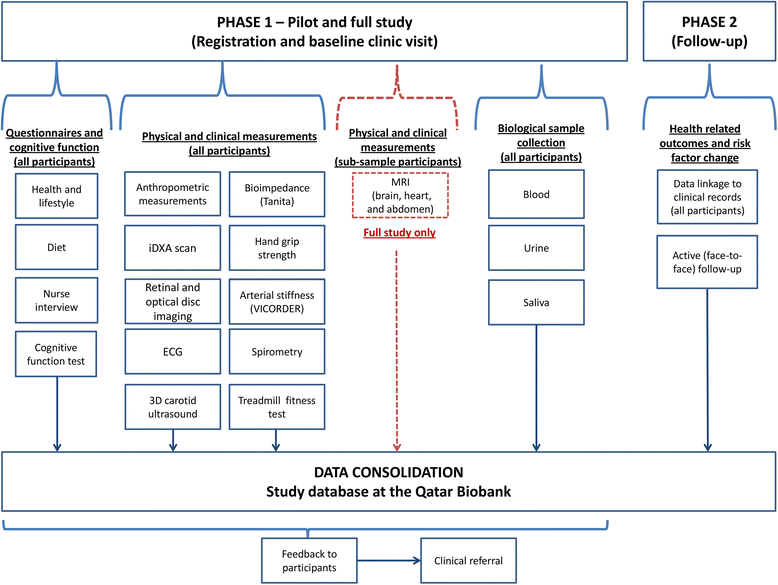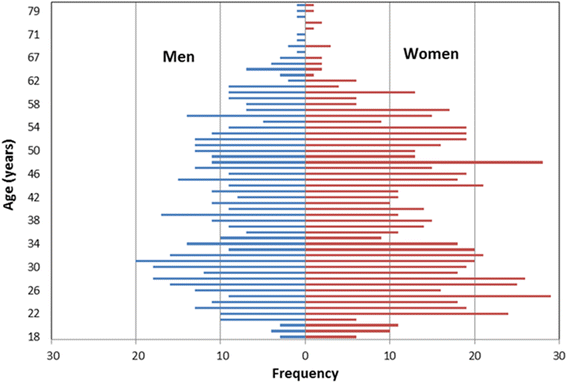The Qatar Biobank: background and methods
- PMID: 26635005
- PMCID: PMC4669623
- DOI: 10.1186/s12889-015-2522-7
The Qatar Biobank: background and methods
Abstract
Background: The Qatar Biobank aims to collect extensive lifestyle, clinical, and biological information from up to 60,000 men and women Qatari nationals and long-term residents (individuals living in the country for ≥15 years) aged ≥18 years (approximately one-fifth of all Qatari citizens), to follow up these same individuals over the long term to record any subsequent disease, and hence to study the causes and progression of disease, and disease burden, in the Qatari population.
Methods: Between the 11(th)-December-2012 and 20(th)-February-2014, 1209 participants were recruited into the pilot study of the Qatar Biobank. At recruitment, extensive phenotype information was collected from each participant, including information/measurements of socio-demographic factors, prevalent health conditions, diet, lifestyle, anthropometry, body composition, bone health, cognitive function, grip strength, retinal imaging, total body dual energy X-ray absorptiometry, and measurements of cardiovascular and respiratory function. Blood, urine, and saliva were collected and stored for future research use. A panel of 66 clinical biomarkers was routinely measured on fresh blood samples in all participants. Rates of recruitment are to be progressively increased in the coming period and the recruitment base widened to achieve a cohort of consented individuals broadly representative of the eligible Qatari population. In addition, it is planned to add additional measures in sub-samples of the cohort, including Magnetic Resonance Imaging (MRI) of the brain, heart and abdomen.
Results: The mean time for collection of the extensive phenotypic information and biological samples from each participant at the baseline recruitment visit was 179 min. The 1209 pilot study participants (506 men and 703 women) were aged between 28-80 years (median 39 years); 899 (74.4%) were Qatari nationals and 310 (25.6%) were long-term residents. Approximately two-thirds of pilot participants were educated to graduate level or above.
Conclusions: The pilot has proven that recruitment of volunteers into the Qatar Biobank project with intensive baseline measurements of behavioural, physical, and clinical characteristics is well accepted and logistically feasible. Qatar Biobank will provide a powerful resource to investigate the major determinants of ill-health and well-being in Qatar, providing valuable insights into the current and future public health burden that faces the country.
Figures



References
-
- Qatar Information Exchange. Worksheet List [http://www.qix.gov.qa/discoverer/app/explorer?node=2&event=expand&state=...]. [accessed 23rd November 2015].
-
- Ministry of Development Planning and Statistics. Monthly figures on total population in Qatar [http://www.mdps.gov.qa/portal/page/portal/gsdp_en/statistics_en/monthly_...]. [accessed 23rd November 2015].
-
- Haj Bakri A, Al-Thani A. Chronic Disease Risk Factor Surveillance: Qatar STEPS Report 2012. Qatar: The Supreme Council of Health; 2013.
-
- Finucane MM, Stevens GA, Cowan MJ, Danaei G, Lin JK, Paciorek CJ, et al. National, regional, and global trends in body-mass index since 1980: systematic analysis of health examination surveys and epidemiological studies with 960 country-years and 9.1 million participants. Lancet. 2011;377:557–567. doi: 10.1016/S0140-6736(10)62037-5. - DOI - PMC - PubMed
-
- Joffres M, Falaschetti E, Gillespie C, Robitaille C, Loustalot F, Poulter N, et al. Hypertension prevalence, awareness, treatment and control in national surveys from England, the USA and Canada, and correlation with stroke and ischaemic heart disease mortality: a cross-sectional study. BMJ Open. 2013;3:e003423. doi: 10.1136/bmjopen-2013-003423. - DOI - PMC - PubMed
Publication types
MeSH terms
Grants and funding
LinkOut - more resources
Full Text Sources
Other Literature Sources
Medical

